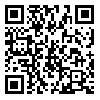Volume 22, Issue 2 (8-2020)
yafte 2020, 22(2): 11-21 |
Back to browse issues page
Department of Biomedical Engineering, Science and Research Branch, Islamic Azad University, Tehran, Iran
Abstract: (2727 Views)
Background: Keratoconus is a common disease characterized by progressive corneal slimming and steepening. The disease progression is generally accompanied by the significant decline in the vision, aggravation of irregular corneal astigmatism and the resultant decrease in the patient's quality of life. One of the successful treatments for Keratoconus is the corneal ring implantation. The prediction of post-surgical visual characteristics has been considered in this study to assist the ophthalmologist in appropriately choosing surgery candidates.
Materials and Methods: In this study, the set of data collected from numerous tests of visual characteristics performed before and after implanting the keraring and myoring rings has been utilized. By using MATLAB software, the visual characteristics of keratoconus patients after implanting the rings have been estimated through correct training of the proposed neural networks. The characteristics include: uncorrected visual acuity (UCVA), sphere (SPH), astigmatism (Ast), orientation of astigmatism (Axis), and best corrected visual acuity (BCVA).
Results: In this research, for the first time, the visual characteristics of keratoconus patients six and twelve months after implanting the corneal ring have been predicted with the mean error of 9.51% manipulating a novel neural-network-based method.
Conclusion: The results indicate the precision and accuracy of the proposed method in predicting the visual characteristics of keratoconus patients after implanting the corneal rings. The ophthalmologist could precisely choose the right candidate for surgery amongst his patients based on the estimated characteristics.
Materials and Methods: In this study, the set of data collected from numerous tests of visual characteristics performed before and after implanting the keraring and myoring rings has been utilized. By using MATLAB software, the visual characteristics of keratoconus patients after implanting the rings have been estimated through correct training of the proposed neural networks. The characteristics include: uncorrected visual acuity (UCVA), sphere (SPH), astigmatism (Ast), orientation of astigmatism (Axis), and best corrected visual acuity (BCVA).
Results: In this research, for the first time, the visual characteristics of keratoconus patients six and twelve months after implanting the corneal ring have been predicted with the mean error of 9.51% manipulating a novel neural-network-based method.
Conclusion: The results indicate the precision and accuracy of the proposed method in predicting the visual characteristics of keratoconus patients after implanting the corneal rings. The ophthalmologist could precisely choose the right candidate for surgery amongst his patients based on the estimated characteristics.
Keywords: Keratoconus, Visual characteristics, Prediction of characteristics, Tests of visual characteristics, Ring implantation, Neural network method.
Type of Study: Research |
Subject:
چشم
Received: 2019/08/21 | Accepted: 2020/06/23 | Published: 2020/09/14
Received: 2019/08/21 | Accepted: 2020/06/23 | Published: 2020/09/14
| Rights and permissions | |
 |
This work is licensed under a Creative Commons Attribution-NonCommercial 4.0 International License. |



